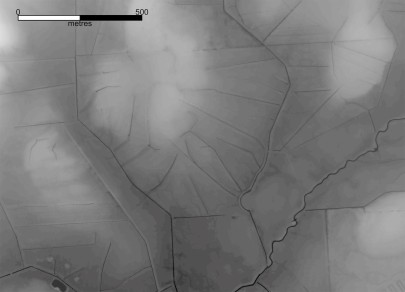
LiDAR image showing drains (the linear, channelled elements) in the study area.
Drainage has historically been seen as an intrinsic component of land management in New Zealand, resulting in extensive construction of drainage systems across the country. This activity has seen the natural extent of wetlands decrease by around 90% since human arrival in New Zealand.
Recent research, led by Manaaki Whenua ecologist Dr Olivia Burge and published in the New Zealand Journal of Ecology, shows that while recent efforts have been made to restrict new drainage close to existing wetlands, the extent of existing drainage in or near wetlands nationally is unclear.
“Wetlands on peat are particularly sensitive to lowered water tables and can effectively subside and shrink when drained,” says Dr Burge. “Drainage systems can cause the loss of key wetland species, an increase in weediness, declines of native wetland species diversity, and further wetland loss and degradation.”
While there is a national drains spatial layer, this has never been used to explore where drains occur near wetlands. Dr Burge and her team are the first to look at the area of wetlands within 100m of drains using LiDAR. Co-author Dr Hugh Robertson, a wetland ecologist from the Department of Conservation, says they developed a model to identify drains using LiDAR which they then compared with the national drains spatial layer for the Waituna catchment of Southland.
“As LiDAR is more sensitive to detecting drains in the landscape, it showed the area of wetlands potentially affected by drains is more extensive than the national layer might suggest,” says Dr Robertson.
Dr Burge says, “not only does this work help us to better detect drains around wetlands and identify where the potential risks from drainage exist, it also has the potential to be scaled up nationally to complement the mapping of wetlands down to 0.05ha, which is required to be completed by 2030 under the NPS Freshwater Management”.
Co-author Dr Janet Wilmshurst, also from Manaaki Whenua, adds "this is good news for small wetlands which are disproportionally important in conserving biodiversity but are currently too small to be mapped. As LiDAR coverage becomes more widely available, this technique will be able to better assess the risks from drainage to all wetland habitats regardless of size over New Zealand and help to safeguard the future of these ecologically important and vulnerable ecosystems.”
